Candy CA CDM 64 AL Handleiding
Bekijk gratis de handleiding van Candy CA CDM 64 AL (21 pagina’s), behorend tot de categorie Afzuigkap. Deze gids werd als nuttig beoordeeld door 115 mensen en kreeg gemiddeld 4.6 sterren uit 58 reviews. Heb je een vraag over Candy CA CDM 64 AL of wil je andere gebruikers van dit product iets vragen? Stel een vraag
Pagina 1/21

INSTRUCTIONS FOR INSTALLATION AND USE
MONTAGE- UND GEBRAUCHSANWEISUNG
INSTRUCTIONS POUR L'INSTALLATION ET L’UTILISATION
ISTRUZIONI PER L'INSTALLAZIONE E L’USO
INSTRUCCIONES PARA INSTALACIÓN Y USO
INSTRUÇÕES DE INSTALAÇÃO Y UTILIZAÇÃO
AANWIJZING VOOR GEBRUIK EN INSTALLATIE

ENGLISH
DESCRIPTION
The unit can be found in filtering hoods, exhaust hoods or in hoods with an outside motor.
In the Filtering hoods (Fig. 1)
the air and steam taken up by the unit are purified with carbon filters and returned to the environment through the aeration
grids on the side of the flue. WARNING: When using filtering hoods, both carbon filters and an air deflector must be used.
Located in the upper part of the pipe, this deflector recycles the air to the environment (Fig. 1A).
In the Exhaust hoods (Fig.2)
an exhaust duct conveys the steam and cooking odors directly outside through the wall/ceiling. Therefore they do not
require carbon filters.
In the hoods with an outside motor (Fig. 3), a vacuum suction unit must be connected; this exhaust
will operate separately, conveying the exhaust air through the unit. Only use vacuum units suggested in the original
catalogue.
INSTALLATION
To facilitate installation, before starting remove the grease filter/s: press inward on the clamp at the handle and pull the
filter downward (Fig. 4).
Installation on the wall (Fig. 5): Using the special drilling template, drill the required holes in the wall. As previously
specified in the chapter “Warning” remember there must be a minimum of 650 mm between the bottom edge of the hood
and the stop of the stove. Secure the metal bracket (B) to the wall using the screws and plugs (bracket, screws and plugs
are all supplied with the unit). Use the 2 triangles cut into the bracket to position it precisely along the vertical axis of the
hood. Then set the hood onto the bracket. Adjust the horizontal position, shifting the hood to the right or left as needed
lining it up with the wall units. If the height of the hood also requires adjustment, use the special regulation screws (V)
(supplied). Once regulation has been completed, finish securing the hood with 4 more screws (M): mark the points for the
4 holes on the wall, remove the hood and drill (8mm diameter holes); then use the plugs and screws to complete installation.
Installation with rear panel (Fig. 6): The rear panel is positioned at the top of the stove, flush against the wall. Rest the
lower edge of the panel behind the stove and anchor the upper edge to the wall using the two holes found on the panel.
Insert the screws and plugs provided (A). The unit is secured to the rear panel as though it were being installed on the wall:
use the supplied metal bracket (B) and the screws and plugs supplied with the panel.
Mount the plate of the electrical system fixing it with 3 screws and 2 metal washers (Fig. 7).
Securing the extension pipes:
Basic installation requirements: – Set the electrical power supply within the space covered by the decorative piping. – If
your unit is installed in an Exhaust hood or in a hood with outside motor, prepare the air exhaust hole.
When installing exhaust hoods and hoods with outside motor, to achieve the best possible conditions use an air exhaust
pipe that : is as short as possible, has a minimum of curves (maximum angle: 90°), is made of a material that complies
with the standards (which vary from nation to nation) and iv) is smooth on the inside. It is also advisable to avoid any drastic
changes in pipe section (diameter: 150 mm).
Adjust the width of the extension pipe support bracket (W) using screws A indicated in Fig. 8. Then use the plugs and
screws provided to secure it to the ceiling. Make certain it is aligned with the hood. For filtering hoods, the air exhaust grids
are positioned in the upper part (Fig. 9). For exhaust hoods, turn the upper pipe over so that the air exhaust grid is in the
lower section (Fig. 10).
Exhaust hoods and hoods with outside motors: Connect the hood flange to the exhaust hole in the wall/ceiling using a
flexible pipe.
Only for models with outside motor (Fig. 11): plug the hood into the outside control unit using the special
terminal block: remove wire clamp A and lid B from the wiring junction box. Secure the wire connecting the control unit
to terminal C. Then replace wire clamp A and lid B on the wiring junction box. The other end of the wire is secured to the
terminal block on the outside control unit.
Plug in the hood. Insert the extension pipes setting them on the hood; extend
the upper pipe to the ceiling and secure with the 2 screws (G) - Fig. 12.
Filtering hood: Secure the deflector to the upper pipe using the 4 special screws (provided) – Fig. 13; hook up the flexible
pipe (diameter: 125) to the deflector. Install the reduction (provided) on the hood air outlet point (Fig. 14). Take the 2
assembled extension pipes and set them on the hood; extend the upper pipe to the ceiling and secure with the 2 screws
(G) - Fig. 12.
Extend the lower pipe taping it in place and then connect the flexible pipe to the hood reduction. Plug in the
hood. Extend the lower pipe downward setting it against the hood. Install the carbon filter by pressing the 2 tabs on the filter
down into the special housing (Fig. 15) and rotating upward.
OPERATION
Depending on the model, the unit is equipped with the following commands:
Commands shown in Fig. 16: Button A = turns the lights on/off. Button B = turns the TIMER on/off: press once to turn
the timer on, therefore, after 5 minutes, the motor cuts out (at the same time the selected speed blinks on the display); the
timer remains on if the motor speed is changed. Display C = - indicates the selected motor speed (from 1 to 4); - indicates
Timer On when the number blinks; - indicates Filter Alarm when the central segments is on or blinking.
Button D = makes the motor work (at the last speed selected); pushing the button again, the speeds of the motor are
sequentially selected from 1 to 4; keeping this button pressed for about 2 seconds shuts down the motor.
Button R = resets the anti-grease filters or charcoal filters; when the filter alarm appears (i.e. when the central segment
on the display goes on), the anti-grease filters must be cleaned (30 hours of operation); when the central segment starts

blinking, the anti-grease filters must be cleaned and the charcoal filters replaced (120 hours of operation). Obviously, if the
hood is not a filtering model and does not have a charcoal filter , clean the anti-grease filters both when the central segment
goes on and when it starts blinking. The filter alarm can be seen when the motor is off and for about 30 seconds. To reset
the hour counter, keep the button pressed for 2 seconds while the alarm can be seen.
Commands shown in Fig. 17: Button A = light button. Button B = first speed motor ON/OFF button. Button C = second
speed button. Button D = third speed button. E = motor on light.
Commands shown in Fig. 18: Button A: turns the lights on/off; every 30 hours of operation the corresponding pilot lamp
(S) comes on to indicate that the anti-grease filters must be cleaned; every 120 hours of operation the corresponding pilot
lamp (S) flashes to indicate that the anti-grease filters must be cleaned and the charcoal filter replaced. To restart the hour
counter (RESET), hold the button A pressed down for about 1” (while the pilot lamp S is on). Button B: drives the motor
in first speed (the corresponding pilot lamp comes on); when holding it down for about 1”, the motor cuts out. Button C:
drives the motor in second speed (the corresponding pilot lamp comes on); when pressing the button a second time (while
the pilot lamp is on) , the TIMER is activated and thus the motor stops after 5’ (the pilot lamp flashes). Button D: drives
the motor in third speed (the corresponding pilot lamp comes on); when pressing the button a second time (while the pilot
lamp is on) , the TIMER is activated and thus the motor stops after 5’ (the pilot lamp flashes). Button E: drives the motor
in fourth speed (the corresponding pilot lamp comes on); when pressing the button a second time (while the pilot lamp is
on) , the TIMER is activated and thus the motor stops after 5’ (the pilot lamp flashes).
Pay special attention to the anti-grease filters: if the model purchased has the commands shown in Figure 16: the anti-
grease filters must be cleaned approximately once every 30 hours of operation (when the central segment on the display
goes on or starts blinking). To remove the filters: press inward on the clamps at the handles and pull the filter downward.
Wash out the filter by hand or in the dishwasher using a neutral soap. Once the cleaned filters are reinstalled, keep button
R (Reset) pressed for two seconds to reset the counter. For further information, see the Commands in Fig. 16 in the
paragraph entitled “Operation”. If the model purchased has the commands shown in Figure 17: the grease filter must be
replaced periodically: exactly how often depends on use (at least once every other month). To remove the filter: push inward
on the clamp at the handle and pull the filter downward. Wash out the filter by hand or in the dishwasher using a neutral
soap.
If the model purchased has the commands shown in Figure 18: the anti-grease filters must be cleaned approximately
once every 30 hours of operation (when the light button lamp comes on) - Fig. 18S). To remove the filters: press inward
on the clamps at the handles and pull the filter downward. Wash out the filter by hand or in the dishwasher using a neutral
soap. Once the cleaned filters are reinstalled, to reset the counter hold the light button pressed down for about 1” (Fig.18A)
while the corresponding pilot lamp (S) is on. For further information, see the Commands in Fig. 18 in the paragraph entitled
“Operation”.
Replacing the charcoal filters: If the unit is a filtering hood, the charcoal filters must be replaced: to remove them press
inward on the clamp (Fig. 15) and rotate the filter downward until the 2 tabs can be removed from the housing.
If the model purchased has the commands shown in Figure 16, the charcoal filters must be replaced whenever the central
segment of the display starts blinking (i.e. every 120 hours of operation). If the model purchased has the commands shown
in Figure 17, the charcoal filters must be replaced according to use: on average once every 6 months. If the model
purchased has the commands shown in Figure 18, the charcoal filters must be replaced each time the light button (Fig.18S)
lamp flashes (i.e. every 120 hours of operation).
Lighting: Depending on the model purchased, see Fig.19 or Fig. 20.
Fig. 19: to remove the halogen lamps, turn the locknut counter-clockwise. Replace with the same type of lamp.
Fig. 20: if your appliance has the same kind of lights as in the figure 20, to replace the incandescent light bulbs remove
the anti-grease filters and remove it; replace with light bulbs of the same type.
DEUTSCH
BESCHREIBUNG
Das Gerät kann in Filterversion, in Aspirationsversion und in der Version mit externem Motor geliefert werden.
In der
Filterversion (Abb. 1) werden die durch das Gerät geleitete Luft und der Dampf durch Kohlefilter gereinigt und dann über
die seitlichen Lüftungsgitter der Haube wieder in Zirkulation gebracht. ACHTUNG! Beim Einsatz der Filterversion müssen
die Kohlefilter zusammen mit einem Luftablenker eingesetzt werden, der in den oberen Rohrabschnitt montiert wird und
die Rezirkulation der Luft und Ableitung in die Umgebung ermöglicht (Abb. 1A).
In der Aspirationsversion (Abb. 2)
werden die Dämpfe und Küchengerüche direkt über eine Evakuationsöfffnung in der Wand oder Decke nach außen
abgezogen. Daher sind keine Kohlefilter notwendig. In der Version mit externem Motor (Abb. 3) ist das Gerät mit einer
Aspirationszentrale zu verbinden, die getrennt arbeitet und das Gerät als Verbindungsbasis für die abzuleitende Luft
benutzt. Bitte verwenden Sie nur eine der im Originalkatalog vorgeschlagenen Zentralen.
INSTALLATION
Vor den Montageoperationen muß/müssen zur leichteren Handhabung des Geräts der/die Antifettfilter entfernt werden:
Den Festhalter in der Nähe des Griffs nach innen drücken und den Filter nach unten ziehen (Abb. 4).
Befestigung an der Wand (Abb. 5): Bohren Sie mit der mitgelieferten Bohrschablone die Löcher an den jeweiligen Stellen
an der Wand. Wie bereits im Kapitel “Montage und Gebrauchsanweisung” beschrieben ist darauf zu achten, daß der
Abstand zwischen dem unteren Rand der Haube und der Kochfläche mindestens 650 mm beträgt. Den Metallbügel (B)
Product specificaties
| Merk: | Candy |
| Categorie: | Afzuigkap |
| Model: | CA CDM 64 AL |
Heb je hulp nodig?
Als je hulp nodig hebt met Candy CA CDM 64 AL stel dan hieronder een vraag en andere gebruikers zullen je antwoorden
Handleiding Afzuigkap Candy
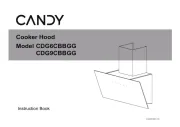
4 Juli 2025
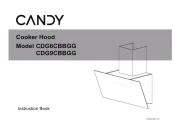
4 Juli 2025
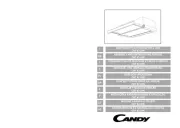
4 Juli 2025
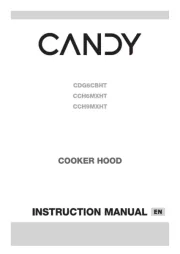
16 Juni 2025
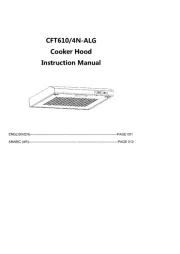
15 Juni 2025
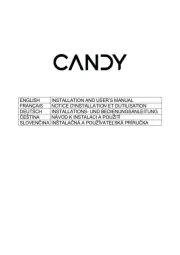
24 Maart 2025

31 Juli 2024

31 Juli 2024

30 Juli 2024

30 Juli 2024
Handleiding Afzuigkap
- Roblin
- Franke
- Sauter
- Elin
- Logik
- Mx Onda
- Schneider
- Viali
- OK
- Falcon
- LERAN
- Zephyr
- Marynen
- Guzzanti
- Hoover
Nieuwste handleidingen voor Afzuigkap
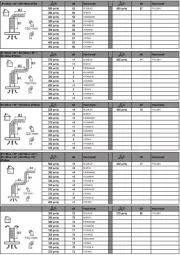
29 Juli 2025
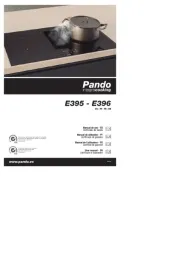
29 Juli 2025
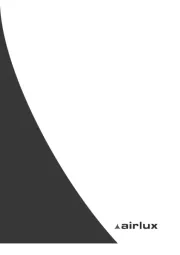
29 Juli 2025
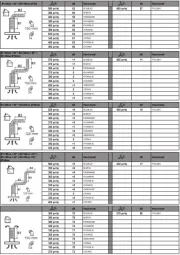
29 Juli 2025
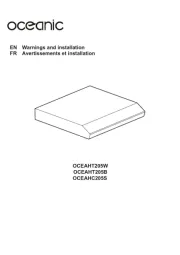
29 Juli 2025
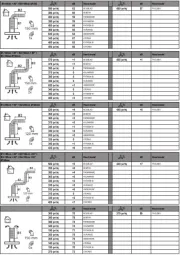
29 Juli 2025
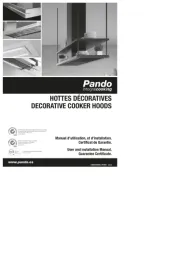
29 Juli 2025
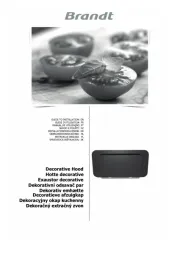
29 Juli 2025
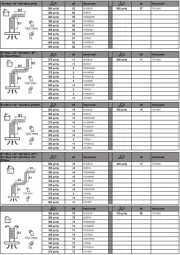
29 Juli 2025
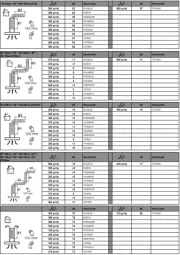
28 Juli 2025